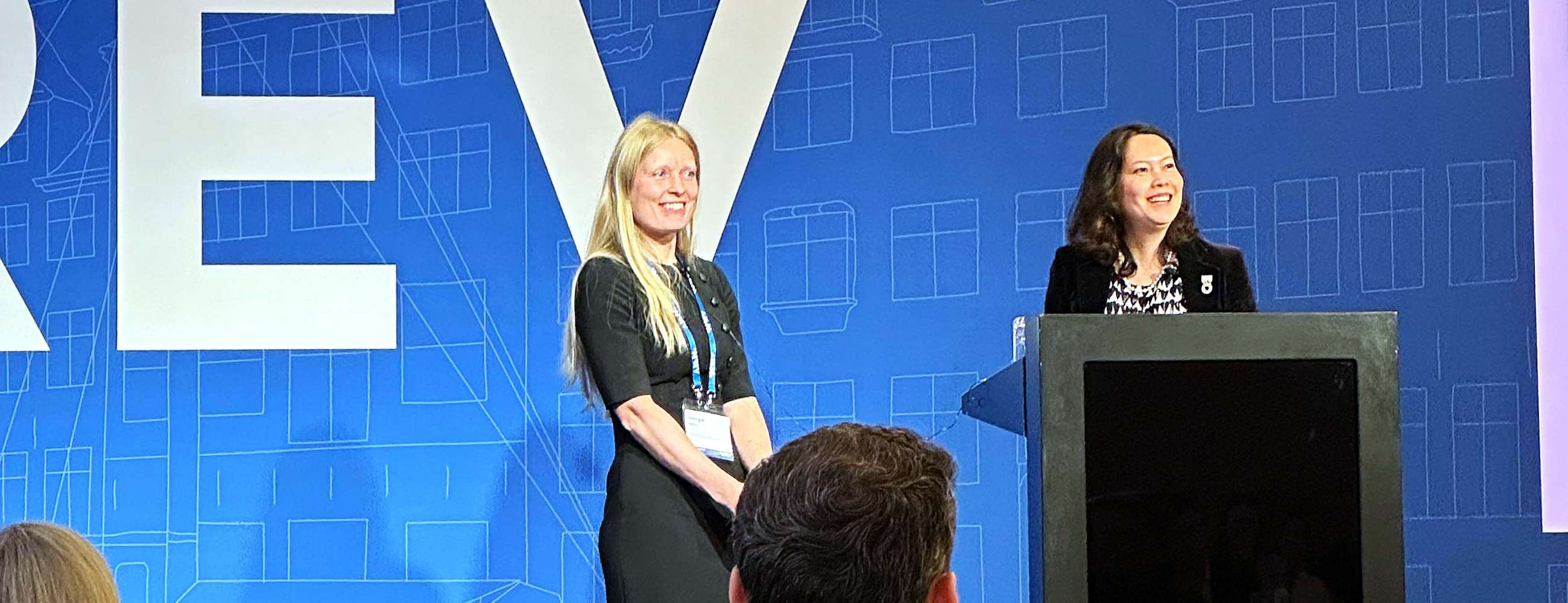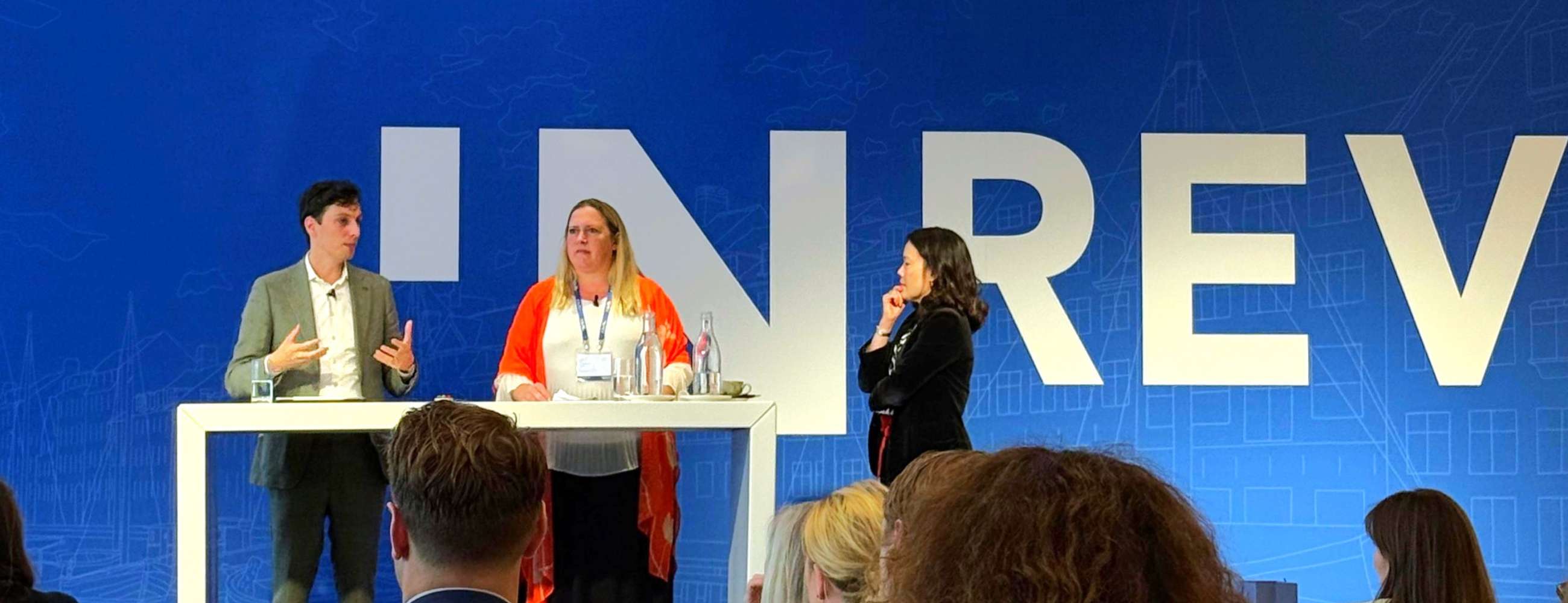ESG Conference 2025: Highlights
The INREV ESG Conference 2025 took place on a sunny day in Copenhagen on 25 September, under the theme ‘Purpose meets performance: rethinking ESG for real estate’. Building on the momentum of previous years, the event brought together leading voices to explore how ESG can deliver both long-term value and meaningful impact.
The conference opened with a welcome dinner on 24 September at Restaurant Væksthuset, nestled within Copenhagen’s Opera Park. Surrounded by lush gardens of native and exotic plants, the setting echoed the conference’s theme, offering a living example of biodiversity in the built environment. Guests gathered over drinks and dinner in this unique venue, setting the tone for a day of engaging debate and fresh perspectives.
A special thanks to our conference moderator, Shuen Chan from L&G Asset Management, who seamlessly guided us through the day's sessions.
Cutting through the noise: navigating a changing ESG narrative (Mike Berners-Lee)

The conference opened with a thought-provoking keynote from Mike Berners-Lee, Founder of Small World Consulting and Professor in Practice at Lancaster University’s Environment Centre. Drawing from his influential work, including the books "There Is No Planet B" and "A Climate of Truth", Mike challenged the audience to step back and reframe the ESG conversation in the context of a broader global crisis, stressing that while not every challenge can be solved immediately, no transformation is possible unless the problems are first confronted.
He described climate change not as an isolated challenge but as one symptom of a much larger ‘polycrisis’—a convergence of accelerating risks including biodiversity loss, resource depletion and systemic inequality. He warned that humanity is ‘not just breaking records, but smashing them,’ with cascading tipping points pushing us deeper into the Anthropocene.
Mike emphasised that renewables alone will not solve the problem; we must also dramatically reduce energy use and reshape demand. For the real estate sector, this means moving beyond financial metrics and embedding values that cultivate resilience and long-term societal wellbeing.
His message was clear: be brave in your narrative—say it as it is, even when it’s uncomfortable. By shifting perspective and embracing systemic change, the industry can play its role in steering towards a sustainable future.
Beyond compliance: transforming ESG into long-term value (Michele Giddens and Abigail Dean)

In a keynote interview, Michele Giddens, CEO and Co-Founder of Bridges, reflected with Abigail Dean (Nuveen Real Assets) on her pioneering journey in impact investing and the evolution of ESG from its early roots in ‘ethical investing’ to a driver of long-term value creation.
Michele shared how, in 2002, she co-founded Bridges with a vision to use private capital as a force for building a more sustainable future—long before ‘impact investing’ was widely recognised. Starting with just £40 million, catalysed largely by government backing, Bridges has since become a leader in demonstrating how investments can deliver both financial returns and measurable social and environmental benefits.
She pointed to retrofitting ‘unloved’ urban buildings into sustainable living spaces and reducing embodied carbon in logistics assets as examples of how Bridges translates ambition into tangible results. While the market does not yet consistently pay a premium for green buildings, she stressed that de-risked, decarbonised assets clearly hold greater long-term value.
For Michele, the challenge is not only about operational carbon but also addressing lifecycle and embodied emissions—a critical step towards achieving ‘True Zero’ buildings. She urged the industry to accept that ‘everything we do has an impact’ and to focus on reducing it wherever possible.
Closing with a personal leadership lesson, Michele encouraged delegates to embrace uncertainty: ‘It is scary to pioneer, but don’t be afraid to do things differently.’
Idealism meets investment: real estate's race to net zero (Julie Townsend, Antoaneta Golling, Marsha Sinnighe and Charlotte Jacques)

Moderated by Julie Townsend, Global Co-Head of Sustainability at PGIM Real Estate, this all-women panel brought together Antoaneta Golling (Prologis), Marsha Sinninghe (a.s.r. real estate) and Charlotte Jacques (Schroders Capital) to explore the practical realities of achieving net zero in real estate.
Marsha Sinninghe highlighted embodied carbon as a critical but still emerging challenge. She described how a.s.r. real estate, working with the Dutch Green Building Council (DGBC), has committed to a pathway for reducing embodied carbon by 2050, starting with targets for new-build assets. With 2050 ‘feeling closer and closer,’ she urged the industry to move from pledges to execution, sharing lessons from successful pilot projects that now serve as blueprints for portfolio-wide action.
Antoaneta Golling framed the challenges through the lens of ‘Power, Product, People.’ Limited grid capacity hampers electrification, innovative low-carbon materials remain costly and difficult to scale, and stakeholder alignment is essential across investors, tenants, and contractors. From a logistics perspective, she noted the lack of embodied carbon benchmarks and the trade-offs between renovation and rebuild, stressing that a long-term investment outlook remains key.
Charlotte Jacques focused on transparency and data, warning that insufficient tools and fragmented standards are slowing progress. Reporting burdens, she argued, consume resources that could otherwise go into performance improvements. She called for a shift in mindset, where sustainability is treated as a core KPI alongside financials, fully integrated into the investment process.
The panellists agreed on the need for consistent methodologies and global comparability. With carbon accounting conducted in up to 16 different ways and floor area measured inconsistently worldwide, Julie emphasised: ‘We want to make it a race, but let’s make it the same playing field with the same transparency.’
The discussion underscored a shared message: to move from idealism to execution, the industry must scale proven pilots, embed sustainability into financial decision-making, and collaborate across stakeholders. Only then can the sector translate its ambitions into lasting impact.
From green to regenerative: unlocking value through nature-positive design (Georgie Nelson)

In her session, Georgie Nelson (Aberdeen Investments) highlighted the urgent need for real estate to address its impact on nature, noting that the sector contributes to four of the five main drivers of biodiversity loss: climate change, resource exploitation, land-use change, and pollution. Invasive species, the fifth driver, can also damage property value, with examples like Japanese knotweed undermining foundations. Georgie stressed the scale of the crisis, citing that we are operating beyond six of nine planetary boundaries and currently in the sixth mass extinction, with roughly one million species at risk.
She framed nature-positive design not just as a compliance requirement but as a strategic opportunity. Protecting value involves meeting evolving standards such as SASB, TCFD, EU Taxonomy, CSRD, and CSDDD, while mitigating physical climate risks like flooding and heat stress. Creating value comes from more resilient, attractive, and marketable assets, with evidence linking greener buildings to higher occupancy, rents, and sales—though data remains fragmented.
Georgie shared practical examples of nature-based solutions and their measurable impacts: Sustainable Urban Drainage Systems (SuDS) can reduce runoff by 60–72%, green roofs can save energy and boost property value by up to 6.9%, green walls reduce indoor temperatures, and street trees sequester CO₂ and lower local temperatures.
A Dutch logistics asset case study illustrated these principles in action. By electrifying heating, installing solar PV, enhancing tenant wellbeing, and integrating biodiversity measures like bat boxes, green walls, and SuDS, the property achieved top EPC ratings and secured a long-term lease with a sustainability-minded tenant.
Georgie acknowledged challenges—limited regulation, inconsistent data, and difficulty measuring ‘embodied nature’—but emphasised that nature-positive strategies offer both risk mitigation and long-term value creation. She closed with a call to collective action, with the words of the famous David Attenborough at COP26: ‘If working alone we are powerful enough to destabilise our planet, surely working together we are powerful enough to save it.’
Audience poll:
What are the top 2 risks globally in 10 years?
- Extreme weather events – 14%
- Societal polarisation – 21%
- Biodiversity loss and ecosystem collapse – 34%
- Misinformation and disinformation – 30%
What is the biggest impact of real estate on the natural environment - in one or two words?
Return and impact: what really matters to investors (Steve Goossens and Laura Chapman)

Moderated by Shuen Chan, this panel brought together Steve Goossens (APG Asset Management) and Laura Chapman (London CIV) to explore how institutional investors define, measure, and deliver impact in real estate while maintaining risk-adjusted returns.
Both speakers emphasised that impact goes beyond ESG compliance, focusing instead on intentionality and additionality. For APG, this means creating new affordable housing units—regular, student, and senior—rather than simply holding existing stock. ESG considerations, including climate mitigation and certifications, are treated as hygiene factors, essential but not sufficient to define impact. Similarly, London CIV integrates impact strategically where risk and return allow, standardising reporting across managers using The Good Economy framework while cautioning against over-reliance on labels to avoid greenwashing.
The discussion highlighted the interplay between scale, mandate, and portfolio context. APG’s €30 billion impact mandate leverages private structures to ensure governance and control, while London CIV’s pooled funds focus on London-based housing, jobs, and environmental initiatives. Both emphasised that impact strategies must be compatible with fiduciary duties: asset-level returns are maintained, with portfolio-level trade-offs carefully considered to maximise additionality.
Measuring success requires robust KPIs. APG tracks the number of new affordable units and supportive metrics such as tenant satisfaction and ESG alignment. London CIV prioritises supply growth in deprived areas while ensuring managers report in a comparable way, complemented by on-the-ground diligence. Place-based risks such as gentrification and displacement are managed through pre-acquisition screening, community engagement, and thoughtful project design.
Both panellists agreed that integrating ESG with returns involves practical levers: aligning new-build projects with environmental targets, engaging managers on emissions data, and embedding decarbonisation across asset lifecycles. Governance, standardisation, and regulatory compliance are critical to avoid reputational risk and greenwashing.
The panel concluded that investors optimise for measurable impact without compromising risk-adjusted returns, combining standardised reporting with local nuance, community engagement, and strategies that add supply in line with societal needs. Open questions remain on scaling affordable housing and converging on common impact definitions and KPIs across geographies.
Audience poll:
Has your organisation incorporated impact investing?
- Yes, fully integrated – 35%
- Yes, we’re exploring or piloting it – 30%
- Not yet, but it’s on our radar – 15%
- No, and we have no current plans – 21%
Value shift: how ESG is reshaping valuations (Aneta Rusiniak)

Aneta Rusiniak, Head of Sustainability (ESG) at Invesco Real Estate Europe, explored how ESG considerations are increasingly shaping investment underwriting and asset valuation. Framing the discussion, she noted that while top-quartile financial performance broadly correlates with strong ESG practices, investors still wrestle with questions such as: will ESG improvements lift rents and yields, and what is the cost of inaction?
Aneta highlighted the distinction between valuation and underwriting. While valuations remain largely backward-looking, capturing ESG impacts takes time, the right expertise, and evidence from transactions. Underwriting, in contrast, is forward-looking: ESG risks and opportunities are increasingly priced in during acquisitions and development, creating the evidence that valuations will later reflect. Market dynamics now recognise ESG as core to defining ‘prime’ assets, with green premiums shrinking and brown discounts becoming more visible.
She introduced six key environmental KPIs critical to underwriting: energy intensity, GHG emissions, energy ratings, transition misalignment, physical climate risk, and building certifications. Invesco’s ESG risk assessment framework benchmarks these metrics against market and regulatory thresholds, flagging Red, Minimum, Recommended, or Best Practice levels. The framework is designed to embed ESG from day one into business-as-usual underwriting and asset plans, supporting CAPEX prioritisation, performance monitoring, and exit planning.
Practical examples illustrated the framework in action: pre-deal energy data influenced acquisition decisions, tenant co-investment in retrofits drove rent uplifts, and structured CAPEX plans mitigated risk while enhancing value. Aneta stressed that while market transparency on the financial impact of ESG remains limited, teams have learned to treat energy and sustainability metrics with the same discipline as traditional financial KPIs.
Key takeaways included integrating ESG into investment committee discussions, benchmarking the six KPIs on all deals, linking audits to CAPEX and business plans, and modelling action versus inaction scenarios at both asset and fund levels. She closed with open questions for the industry: how quickly will valuation practice adapt to forward-looking ESG evidence, and can comparable metrics for rent and yield impacts be standardised across markets?
Audience poll:
Is top quartile financial performance correlated with ESG performance?
- Yes, I agree – 48%
- No, I disagree – 22%
- Do not know – 30%
Redesigning waste: turning plastic into purpose (Marius Smit)

The conference closed with an inspiring keynote from Marius Smit, Founder of Plastic Whale, who challenged delegates to rethink failure, innovation, and the role of creativity in addressing environmental challenges. Framing his talk around the growing global problem of plastic pollution—commonly referred to as ‘plastic soup’—Smit argued that our obsession with perfection often obscures the beauty of failure, where innovation and real impact are born.
Marius shared the origin story of Plastic Whale, beginning with a simple idea: build a boat from plastic collected in canals. Adopting a ‘doing mindset,’ he mobilised a diverse network of lawyers, financiers, recyclers, and boat builders to start plastic fishing. The first event attracted 400 volunteers, and the second 1,200. Today, more than 110,000 people have participated, leading to the creation of the first professional plastic-fishing company, a fleet of boats, and expanded initiatives across the Netherlands.
From waste to products, Plastic Whale transforms collected PET bottles into boat hulls, skateboards, office furniture, and now a tiny clubhouse in Amsterdam. Marius emphasised the power of starting small. He encouraged the industry to embrace failure as a creative force, build cross-disciplinary coalitions, and turn ambitious ideas into tangible impact.
The session left delegates with a memorable message: in tackling the world’s most complex environmental challenges, taking action, experimenting, and learning from ‘loser’ moments is the pathway to meaningful change.
Presentations
Photos
Thank you to our sponsors
